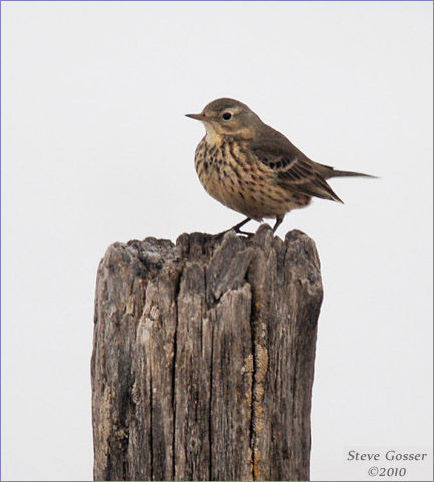
1 November 2010
Yesterday, 31 Oct 2010, I was happy to see a flock of these birds on the exposed, dry mud at Shenango River Lake. I know their identity but they’re tricky, so here’s a quiz.
First clue: He’s not a sparrow because his beak is too thin. Sparrows have deep seed-cracking beaks, this bird does not.
Perhaps he’s a thrush? He has a striped breast, short neck, thrush-like stance, almost-thrush-sized bill, and he walks a lot.
A longer look reveals many “Not Thrush” things about him.
- He’s a little smaller than a Swainson’s thrush. Unfortunately his size is hard to gauge because he’s rarely near anything that gives him scale.
- He is only found in open tundra-like landscape, never in the forest.
- He has wing bars. Our eastern thrushes do not.
- His outer tail edges are white. (You can see this when he flies.)
- When he walks he darts and jabs in a quick manner that’s different from the deliberate walk-and-pause of thrushes.
- He pumps his tail and almost wags it. Hermit thrushes raise then slowly lower their tails. The top side of his tail, which you can’t see in this photo, is not rusty like that of a hermit thrush.
- In flight this bird is bouncier than a goldfinch.
- And like a goldfinch he always calls when he flies. His call is a dead giveaway. He says his name.
Final hint: This bird is a treat to see because he neither breeds nor winters in Pennsylvania.
Ready for the answer? Check the comments.
(photo by Steve Gosser)
an american pipit? haven’t seen one yet, but i am keeping my eyes out. i hear that they like to skulk around in newly tilled fields in the fall so that’s where i’ll be looking.
I looked in my Peterson Guide and also Cornell’s All About Birds for its voice and have come to the conclusion that its an American Pipit.
Yes, American Pipits! Read about them on Cornell’s All About Birds (http://www.allaboutbirds.org/guide/American_Pipit/lifehistory). There are 43 species of pipits. See the list here (http://en.wikipedia.org/wiki/Pipit)
I got that picture last winter up at the Amish farms of Lawrence County. That was the first and only time I had ever seen one that wasn’t on the ground. I remember when I saw my very first one, I was baffled for awhile trying to figure out what it was.
Thank you all your bird watchers/lovers/protectors!!! I so enjoy all this interesting “stuff”. Never heard of this bird, never saw this bird; hope before my time is up I see one.
American pipits, sigh, I have seen and heard them only two times.